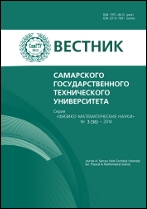|
Differential Equations and Mathematical Physics
On decisions of Schwartz' problem for $J$-analytic functions with the same Jordan basis of real and imaginary parts of $J$-matrix
V. G. Nikolaev
Novgorod State University after Yaroslav the Wise, Novgorod the Great, 173003, Russian Federation
(published under the terms of the Creative Commons Attribution 4.0 International License)
Abstract:
Boundary Schwartz' problem for $J$-analytic functions was studied within this scientific work. These functions are solutions of linear complex system of partial differential equations of the first order. It was considered, that the real and imaginary parts of $J$-matrix are put into triangular form by means of one and the same complex transformation. The main theorem proved a criterion for eigenvalues of $J$-matrix. Shall this criterion be fulfilled within the complex plane within the boundaries defined by Lyapunov line, there is a decision on Schwartz' problem and it is the only one. The equal form of this criterion was found, which in many cases is more convenient for check. While proving the theorem, known facts about boundary properties of $l$-holomorphic functions are applied. The proof itself is based on the method of direct and reverse reduction of Schwarz' problem to Dirichlet's problem for real valued elliptic systems of partial differential equations of the second order. Examples of matrices are given, whereby the specified criterion is fulfilled.
Keywords:
Schwartz' problem, $l$-holomorphic function, Lyapunov line, Jordan form, Jordan basis, characteristic equation, elliptic system, Dirichlet's problem.
Original article submitted 14/IV/2016
revision submitted – 22/V/2016
Citation:
V. G. Nikolaev, “On decisions of Schwartz' problem for $J$-analytic functions with the same Jordan basis of real and imaginary parts of $J$-matrix”, Vestn. Samar. Gos. Tekhn. Univ., Ser. Fiz.-Mat. Nauki [J. Samara State Tech. Univ., Ser. Phys. Math. Sci.], 20:3 (2016), 410–422
Linking options:
https://www.mathnet.ru/eng/vsgtu1491 https://www.mathnet.ru/eng/vsgtu/v220/i3/p410
|

|




 Contact us:
Contact us: Terms of Use
Terms of Use
 Registration to the website
Registration to the website Logotypes
Logotypes









 Citation in format
Citation in format 